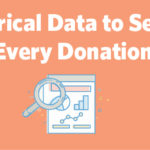Use Historical Data to Send Better Emails Every Donation Season

When you’re a kid you quickly learn the right way to ask for something from your parents, mostly, by remembering what didn’t work.
Rule #321: It’s alright to ask Dad after Mom says no, but only if they’re not home at the same time.
Learning from the past is natural, and you can use your learnings from past email marketing campaigns to inform your strategy for the upcoming donation season. Using historical metrics from your past seasons will help make sure the next few months are better than the last.
How successful is your email marketing? Check out our upcoming webinar: Measure Your Nonprofit’s Email Marketing Success with Reports.
Measure success at the end of each quarter
If you spend all of your time tweaking your email marketing strategy, you’ll never be able to establish any consistency that will lead to success. Instead, let your plan run its course, and wait until the end of each quarter to monitor what’s working and what needs changing. Then, look to see if you’ve been trending upwards, downwards, or if you find yourself on a plateau.
Look for the campaigns driving success and ditch those that aren’t performing. If you’ve fallen into a plateau and can’t see a direction up or down, it may be time to try a bolder approach that will help create a more definable test. Choose a hypothesis you can stick to over the next three months, like adding more humor to every subject line, and see if it changes your metrics, such as boosting open rates.
The metrics that point to what’s working (or what’s not)
Past emails will help you paint a picture of your recent success and also show you the campaigns that didn’t work as well as you’d hoped. Metrics like open rate, click rate, and bounces will help you label certain campaigns successful. For subject lines, look to see which was most engaging and led to the most opens to find the right messaging that works for your audience.
With a visual graph of your past emails, you’re likely to see a spike where a subject line boosted open rates, or a certain call-to-action contributed to more clicks. Dig deeper with custom reports by individual metric to see what is causing the difference. If your spam rates have climbed recently, you may not be providing enough value in your emails, or your subject lines may be too aggressive for your audience.
Which email list is helping your organization most?
If you’ve successfully segmented your email list, you’ll likely have different segments or whole different lists with different metrics and characteristics. Compare your lists side by side to figure out which people are most engaged with your organization, and also which group is contributing the most donations to your cause.
Since each of your lists are different, the same call-to-action may not work for all of them. To make sure you’re focusing your calls for donations to the list that is most willing to donate, compare your open and click rates with the source of your donations. You may find that your most engaged list is not contributing the most donations. Instead, you can use that engaged audience to spread awareness of your cause, and save the calls for donations for the subscribers that are most likely to contribute.
Bigger tests can lead to bigger results
While your organization depends on the donations from your audience to support your cause, you can still test different hypotheses and tweak your marketing strategies at the same time. Sometimes the biggest risks in messaging or strategy lead to the biggest donations, so your organization needs a place to test without hurting your overall reputation.
Instead of taking a risk and testing a bold strategy on your whole audience, segment out a test group to use as a place to test your ideas. If you suspect that some of your audience would respond to you taking a more direct stand on an issue related to your cause, test that theory on a subset of your audience and wait to see how they respond. If your audience supports your views on an issue, they’re more likely to support your organization at the same time.
Validate your successes and learn from your mistakes
Researching your past data lets you learn what works to make it work even harder for your organization, and get rid of the tactics that are wasting your time. Inform your strategy for the upcoming donation season with the metrics that will help turn your call out for donations from no to yes.
Learn more about email reports in our upcoming webinar: “Measure Your Nonprofit’s Email Marketing Success with Reports.”
The post Use Historical Data to Send Better Emails Every Donation Season appeared first on Constant Contact Blogs.
Contributers : Constant Contact Blogs https://ift.tt/2NF3o45
















No comments:
Post a Comment